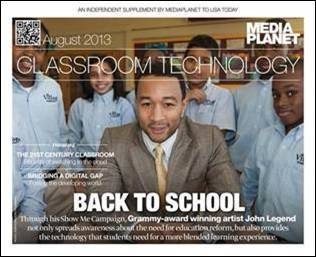Steve Prentice's Blog, page 16
October 11, 2013
Virtualization and Cloud Technology – Moving Forward
In addition to my own posts, I also write for CloudTweaks, an authority on cloud computing. My most recent post covers the work being done by VMware and Hitachi Data Systems on virtualization. he cloud is becoming truly revolutionary in the way it handles data and growth, and my recent interview with Hitachi CTO Hu Yoshida was really quite fascinating. Here is an excerpt:

Hu Yoshida, CTO, Hitachi Data Systems
“It appears sometimes that the shift of both technology and mindset to the concept called the cloud is happening extremely quickly, and although innovation and competitiveness are key concerns for any CEO or executive, the speed by which a company’s entire IT structure must transform can sometimes be overwhelming.”
“This is something that the experts at VMware and Hitachi have known for a long time, and is the reason why their 10-year relationship has done so well for their clients: they are very good at explaining the how’s and why’s of the shift towards the cloud and its necessity going forward.”
“Take the Software Defined Data Center, for example. This VMware concept allows, in the most basic terms, for a transition to a virtual world, in which all the elements that drive an IT system are no longer tied to hardware, but reside in a virtual layer, allowing IT technicians to make upgrades and add additional functionality without having to pop the hood and pull out and replace an actual component. When you combine this with flash-based virtual storage systems, a company becomes better able to capitalize on its ever growing need for storage space, processing speed and data transfer without having to resort to greater investment in “spinning disks.””
To read more, please visit CloudTweaks here.


October 3, 2013
You’re On Your Own
 If there’s one thing that the U.S. Government shutdown proves it’s this: you’re on your own. In the hours before the deadline, companies and departments were asked to draw up lists of essential and non-essential personnel. Imagine commuting back home at the end of the day and asking yourself, “after all the schooling I completed, after all the work I put into this department, after all the team-building events, motivational speeches and training days, all of the emails I returned on weekends, I may still be a non-essential part of this organization.”
If there’s one thing that the U.S. Government shutdown proves it’s this: you’re on your own. In the hours before the deadline, companies and departments were asked to draw up lists of essential and non-essential personnel. Imagine commuting back home at the end of the day and asking yourself, “after all the schooling I completed, after all the work I put into this department, after all the team-building events, motivational speeches and training days, all of the emails I returned on weekends, I may still be a non-essential part of this organization.”
You’re on your own.
Not every working person is subject to the furlough, of course, but every working person is subject to the fear. What if I am no longer needed? What if I lose my job?
I work with people like this – people who have recently been “let go.” We laugh grimly at the terminology. “Let go.” Like a dove or a handful of balloons, passively released to rise from the tedious bondage of a secure job, taking with it any vestiges of guilt that may be harbored by those who remain.
I know that the individual people who do the firing or the furloughing or the laying-off will, in most cases, agonize over the action. Most people are not, after all, made of stone. However the company as an entity feels far less pain; it has liberated and freed an individual whose value, it seems was not enough to warrant its continued care.
I talk to people about fear all the time. I ask people what fears they hold and how they react to them. Many people fear for their own health and safety. All people fear for the safety of those they love. Fear is an instinctive reaction that forces a person to turn or run away from a threat. Fear can cause panic, but it can also elicit courage.
The fear of losing one’s job sits very high on this list. The loss of a job means more than a loss of identity, it represents failure – financial, career, family and health. Yet most people, working as hard as they do, for the employer they currently have, push this fear to the back of their minds, believing that careful and diligent adherence to the plan, answering all the emails, taking on the extra work of an atrophied workforce, sacrificing family time and vacation time to get things done – will buy their safety and keep the axe away.
Part of my role is to help people confront fear through action. If you fear something, the best thing you can do is to take an action that helps dissolve the threat. When it comes to the fear of being let go, left behind or shut down, the action is to ensure you have the network and the knowledge in place to ensure your value to your industry is clearly visible.
This is what I have been teaching through my endless and wonderful Wolf On Wheels tour. When it comes to career management, you are on your own. But this time in a good way. The tools to connect you with the right people are available online. The tools that will help you continue to learn the trends in your industry from the experts and analysts are online. The tools that will help you announce your value and establish credibility are online, too.
The age of cradle-to-grave employment has long passed. We are in an era now where jobs are hard to find and hard to keep, and where it is projected that a significant portion of the workforce will be freelancers in a very short time.
This, I believe, is a good thing. This is why I gave my book the title Work Like a Wolf, because I believe we all have the capacity (or must develop the capacity) to hunt down opportunity in an active fashion, rather than wait and hope for someone to hand it to us. Those “someones” are getting fewer and further between.
So yes, you are on your own. You are your own best ally when it comes to the battle to survive, because you are the one you can trust the most. Let the furlough deliver a dividend to you in the form of this wake-up call: you are responsible for your own future, and there has never been a better time in all of human history to take advantage of the tools and methods availble to help you.
Go and hunt your destiny. You deserve the best, but only you can find it.
For more information on the Wolf On Wheels Tour – Putting People Back to Work One Town at a Time, visit the website here.


September 28, 2013
The Future of Your Company, Hashtags and All

Fallon and Timberlake’s Hashtag Sketch. Click to watch.
In addition to my own posts, I also write for CloudTweaks, an authority on cloud computing. My most recent post covers a recent sketch performed by Jimmy Fallon and Justin Timberlake, which looked at the way hashtags are used and how silly they would sound in spoken language. The skit, in my view reveals a whole lot more about the fores of change in business and the need for decision makers to get on board. Here is an excerpt:
“Recently the unofficial comedy team of Jimmy Fallon and Justin Timberlake performed a short skit that illustrated how silly hashtags sound when inserted into normal conversation. http://youtu.be/57dzaMaouXA The idea of punctuating a sentence with keywords intended as flags-to-be-found is of course, ludicrous in spoken parlance, but as Shakespeare and Chaucer both wrote, many a truth is spoken in jest. The humor of the Fallon/Timberlake skit underlies a very real truth that language, just like culture and life itself, is morphing to accommodate a new way of being, and written language is now expected to be seen online, where interaction is expected and where calls-to-action through hashtags and twitter mentions are essential.”
“These cultural references demonstrate that the age of the cloud is here. Everything exists “out there,” in an instantaneous and globally ubiquitous fashion. Such an observation is not limited to technologies of course. The same customer mindset that expects free wi-fi at every street corner and free apps for its numerous connected devices, is not going to easily file in to a boardroom for a staid two-hour meeting whose format has not changed since the 1960’s. Nor will it sit on a website that takes more than a second to process or update. Nor will it stay loyal to anything, when it knows there is something better, cheaper and easier just a hand-swipe away.”
To read more, please visit CloudTweaks here.


September 12, 2013
Time Management: Developing Habits
I write for Time Management for iPad Magazine, an authority on Time Management. This link takes you to Issue 12, which includes an article I wrote on developing habits. Here is an excerpt:
“Old habits are hard to break. New habits are hard to keep. This is because habits are conditioned actions that are worn into a person’s physiology after a great many repetitions. Think, for example, when you are driving your car and you have an experienced driver riding with you in the passenger seat. This person will involuntarily move their right foot in a braking reflex at the moment he/she determines a need to brake, even though, consciously this person knows that you are the one actually in control of the car.”
“In addition to repetition, a habit also needs a reason to exist; something has to make it worthwhile. If you noticed one day that there was a fifty dollar bill taped to the streetlamp pole near your house, you would probably think it was your lucky day. If it happened a second time, you would think it strange, but pleasant. After third and fourth time, your habit of walking would change in terms of route or timing in anticipation of seeing a daily financial bonus attached to the post. The day it stops happening, you will feel disappointment, but the urge to continue walking this route will last for a long time afterwards, because in addition to repetition, habits are supported through positive reinforcement…”
To read more, please click here.


September 10, 2013
The need for High-Tech in the classroom

Back To School – USA TODAY supplement
In addition to my own posts, I also write professionally for CloudTweaks, an authority on cloud computing. My most recent post covers a supplement that was published in USA TODAY, sponsored in part by MediaPlanet, regarding the need for high-tech in the classroom. The section included an article from Vint Cerf (father of the internet), and Grammy-winning musician John Legend, as well as an article by CloudTweaks writer Adam Hausman. Here is an excerpt:
“With the back-to-school season now upon us, parents, students and teachers everywhere are once again struggling with the perpetual challenge of making kids job-ready in a high-speed and fast-changing environment. There is little doubt in anyone’s mind that information technology plays a central role in all areas of life but sadly, access to this technology and the subsequent reaping of its benefits often stays out of reach, either due to lack of funding, lack of familiarity, or outright resistance.”
“In a recent USA Today special feature, in which CloudTweaks played a central role , Dr. Steve Paine, President of the Partnership for 21st Century Skills (P21), pointed out that “sixty-five percent of today’s students will have a job that has not been invented yet.”
To read more, please visit CloudTweaks here


August 30, 2013
Bob Culbertson: Master of the Chapman Stick

Bob Culbertson playing the Chapman Stick
In addition to my work as a journalist, I am also a musician. I play guitar and sing for the corporate dance band, Absolutely Jack. Recently I had the good fortune to hear a remarkable musician. His name is Bob Culbertson and he plays the Chapman Stick. I saw him busking, basically, on Pier 39 in San Francisco. The full blog is posted on the Absolutely Jack WordPress site.
Here is an excerpt:
“Walking along the Embarcadero in San Francisco very recently, I heard the most beautiful music floating across the late afternoon breeze. It sounded like a trio, playing a gorgeous flowing piece of easy-listening jazz; there was no percussion, but something that sounded like a marimba, accompanying a harp or two – an actual sit down harp, not a harmonica.”
“I approached Pier 39 in search of the trio, but what I found was something and someone far more amazing. I had discovered Bob Culbertson, master of the Chapman Stick. He was playing a tune I did not recognize, but I stood enthralled for a full ten minutes, listening, for it sounded like he carried an entire band in his two hands…”
To read more, click here.


August 27, 2013
Retro-Future: The CDW Bus
In addition to my own posts, I also write professionally for CloudTweaks, an authority on cloud computing. I am currently covering VMWorld, a gigantic hight-tech conference being held in San Francisco that focuses on virtualization and cloud technology. My most recent post covers the innovative-yet-retro technique being used by solutions company CDW to promote their services. by far the coolest looking thing I have seen on the exhibit floor. Here is an excerpt:

CDW’s FutureLiner
“…Whereas all of the other vendors at the convention use sophisticated graphics and animations to illustrate their virtual product, CDW decided to put it all inside a vintage GM FutureLiner (The concept of a Futureliner), and take it out on the road. As their PR specialist Dan Vargas explains, the bus was first produced in the late 1940′s, and early 1950′s to address the postwar appetite for the new and futuristic. What better way is there, he says, to demonstrate the new and futuristic vision of cloud and virtualization than to package it inside a really retro-cool looking vehicle.”
“…Although the bus is somewhat dwarfed by the enormous space of the Moscone Center, Vargas tells CloudTweaks that they drive the vehicle to all kinds of events including tailgate parties. Inside, carefully constructed display cases show off racks of servers and machines from all of the major players, highlighted in sleek red lighting.”
To read more, please click here.


August 21, 2013
Amazon, Amaz-off, Amaz-on-again
In addition to my own posts, I also write professionally for CloudTweaks, an authority on cloud computing. My most recent post covers the recent outages at Amazon.com and Google, and their relationship to Dick Van Dyke’s burning car. Here is an excerpt:

Dick van Dyke’s burnt out Jaguar sports car. Photo credit: Arlene Van Dyke/Vine.com
“On the afternoon of Monday August 19, two strange and unsettling events occurred. First, the perpetually-available ecommerce behemoth Amazon.com vanished, taking its Canadian cousin, Amazon.ca along with it. Shoppers were greeted with a 404 Not Found/Fail Whale page and were encouraged to come back later. The outage lasted somewhere between 20 and 40 minutes.”
“The second strange and unsettling event happened on a freeway north of Los Angeles, where actor Dick Van Dyke narrowly cheated death after his Jaguar burst into flames. He was pulled to safety and suffered no injuries. Ironically, the car was reduced to just soot and ashes.”
“These two events follow on the heels of a brief and unexplained outage at Google on August 16, which was calculated to have cost Google about half-a million dollars in lost ad revenue, and resulted in an enormous 40% drop in web traffic…”
To read more, please visit CloudTweaks here.


August 20, 2013
Unfolding The Camel: Problem-Solving In A Multi-Cloud Environment

My company’s cloud strategy looks like this.
In addition to my own posts, I also write professionally for CloudTweaks, an authority on cloud computing. My most recent post covers the challenges of problem solving in a multi-cloud environment. Here is an excerpt:
“There is an expression that says “a camel is a horse designed by a committee,” which means, of course, that the more people who are involved in a decision-making process, the less the end product resembles its intended objectives. But camels aren’t always designed. Sometimes they simply emerge from their surroundings, growing fatter and more belligerent daily.”
“IT people encounter these camels all the time. Seldom is a data center built in such a way that every element is clearly defined. In fact most organizations have complex, virtualized systems that have been built up and out, adapting to new trends and needs, moving from open-source to commercial, leaping onto the cloud, and then back in-house again, in short, building a complicated camel that few traditional systems are capable of diagnosing and maintaining…”
To read more, please visit CloudTweaks here.


August 17, 2013
Seeking Innovation between the Last Minute and the Critical Path
Google’s Black Light Aquarium Room
It has been announced in various places, including Quartz and the Huffington Post that Google has effectively closed down its 20-percent time policy, which allowed employees to work on side projects for up to one fifth of the workweek. Along with the black light aquarium room, the excellent food, and the fleet of wi-fi buses, this block of company-sanctioned experimentation time made Google the go-to-place for smart designers, thinkers and programmers. Google was the do-no-evil wonderkind that nimbly stepped clear of the vast and dull corporate shadow being cast by Microsoft. At the heart of its growth was the wonderfully innovative idea that a company could be built basically on a product called knowledge.
Now I myself have never been CEO of a global colossus the size of Google, so I shall not presume to say I know to run a company of that size any better; however I have worked with the employees of companies large and small for twenty years now, and one thing I do know: innovation cannot be hatched from cubicles.
The workplace, whether its product is data, insurance, cars, law, or any one of a million other items, remains a collective of square holes into which the roundish heads of humans are forced. The expectation is that productivity comes from an eight or nine hour day, and that anything left over can be caught up at home. Cubicles are square; the blocks on the Microsoft Outlook calendar are square, and the boxes on the corporate hierarchical org chart are all square.
Humans, however, do not fit this square mold; they are flexible, organic and reactive. Their capacity for creative thought, for focus, for collaboration and for problem solving ebbs and flows with the chemistry of their blood, with quality of the sleep they had a few hours earlier, and with the impact of the day’s stresses on their nervous system. People’s brains do not solve problems or come up with brilliant ideas by staring at a blank computer screen. Ideas come when the eyes and hands are distracted by other things, at which point the brain has time to move around and unravel segments of its tightly wound processing system.
That’s what made Google’s black light aquarium room so great. It wasn’t a place to hide from the boss or burn off a hangover; it was a place to keep the eyes busy while the brain did its work. The same applied to the Google staircase, where people were able meet and talk informally. These were the synergy machines; the brainstorming centres.
There seems a time, however, when bright young companies suddenly hit middle-age. For some it is when they go public, and they trade in the youthful fires of energy and idealism for a huge pile of cash and a boardroom full of imagination-free masters. For others, it is a size issue. As soon as a company needs an HR department, it has moved, emotionally, from motorcycle to minivan. And once a company turns inward, the focus becomes less on innovation and more on just getting the work done.
Yahoo’s recent and highly public recanting of its work-from-home policy is an example. Working from home has never been looked upon kindly by the managers of the world, regardless of the industry. After all who knows whether an employee is really doing the work assigned? Thus the nickname “shirking from home.”
The problem seems to be that many companies including the smart ones, seem to confuse face-time with quality output. For example, Jody Thompson, co-founder of consulting firm CultureRx, was quoted by Bloomberg stating that Yahoo CEO Marissa Mayer “has taken a giant leap backward…instead of keeping great talent, she is going to find herself with a workplace full of people who are good at showing up and putting in time.”
Productivity and innovation need room, time and opportunity to develop. In most companies, employees are trapped on an eternal critical path. Workload and deadlines clash with delays and wasteful practices so that every task being worked on bumps up against the next one, shunting them all down the line out the door and into personal time. Human beings cannot work well under pressure, and the critical path of an overstretched workforce is a prime manufacturer of that pressure.
I have met many people who claim to work best at the last minute; the adrenaline and energy of quickly arriving deadlines forces them to be at their best. However, based on my company’s analysis of their results, I have to disagree. They are forced to be the best they can be at that moment, certainly, since the human nervous system is programmed to be reactive and to kick into action-mode whenever a threat is present. However, high-energy output is not the same as high quality output. For example every document, presentation or proposal could be at least fifty percent better, more powerful and more concise when a smart person gives him/herself the time to plan, prepare, review and rewrite. But who has time for that?
Now this issue is not new. It has existed for most of the post-war high-tech age. However what is new is the mobility of the workforce upon which such companies rely. Professionals of all ages, from new grads to 50-somethings seeking a second, third or fourth career, are realizing that their best opportunity for a fulfilling and secure job might actually come from outside the well-manicured perimeters of a publicly traded company. Freelancing, contracting, and networking are becoming the essential skills of the new economy.
I recently interviewed a CEO who stated that when hiring new grads he always looked for candidates who had scored B’s and C’s in school, because, he said, these people know how to talk and communicate. Social skills, he said, were more important, since they were the catalysts for ideas, innovations and relationships.
When I read about an organization that has folded in on itself and has replaced the spark of innovation with the slow-burning wick of administration, I ask myself, “How long will the goods ones stay there?” One need only look at the huge collection of start-ups, niche companies and self-employed experts, whose stock-in-trade is creativity, innovation, and agility. These individuals and companies recognize that they are the authors of their own success or failure. As such it is incumbent on them to stay great, competitive and employable. That’s the original spark that has always made great things happen.









